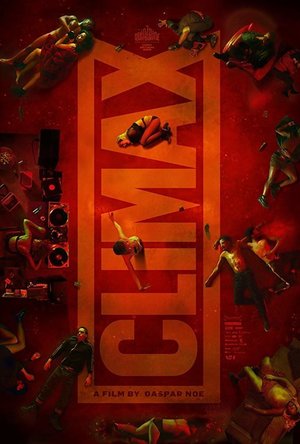
Idioms and Slang Dictionary - Word History & More
Reference and Education
App
Idioms and Slang Dictionary by Farlex gives you definitions and examples from top sources like...

MosaLingua Apprendre l'Anglais
Education and Travel
App
***Learn English in no time!*** MosaLingua's effective and addictive teaching method will help you...

Learn French - MosaLingua
Education and Travel
App
Learn French in no time! MosaLingua's effective and addictive teaching method will help you memorize...

Learn Spanish: MosaLingua
Education and Travel
App
***Learn Spanish in no time! MosaLingua's effective and addictive teaching method will help you...
Gareth von Kallenbach (980 KP) rated Climax (2018) in Movies
Jul 2, 2019
The setting for Noé’s latest tour of human horrors is the final rehearsal of a French dance troupe set to tour internationally. The film begins with the final scene of the movie and the ending credits. Then, just as your confusion has built to appropriate levels, things actually begin with videotaped interviews of all 22 members in an attempt to give you some semblance of character introduction. Shown on an older TV, the screen is surrounded by books and plays focused on ultra-negative philosophical views and subjects such as schizophrenia and suicide. So, despite the rather upbeat and optimistic responses of the prospective dancers, the tone is already being set for the madness that is about to commence.
From there we are taken to the big dance number. A ten-minute single shot involving the entire cast choreographed to 90’s EDM music. While this scene felt a little bit long, it did nearly as much to introduce the characters as the audition tapes shown earlier. Each dancer has a unique style and flair that executes a certain character development. Once the dance is complete it feels like the movie finally begins and the cast starts their post-rehearsal party. The soiree involves dancing (of course), drinking (homemade sangria) and some minor cocaine use. But it mostly consists of quick shots between different cast members taking part in some intergroup gossip. We are treated to one more (non-choreographed) dance scene with each individual showing their talents in a circle of their comrades, then we break again for more conversation. As the party continues on everyone starts to feel a little bit funny. They quickly deduce that the sangria has been spiked with LSD, but cannot determine who drugged them.
And this is where the hour-long journey into hell embarks from. The realization that they have been drugged seems to worry them very little, but does instantly turn them all against each other. The effects of the LSD ramp up rather quickly and as the cast members descend into madness the audience is treated to a myriad of trauma and depravity including: rape, incest, self-mutilation, child electrocution and an attempted abortion via a swift kick to the stomach. None of this should be any surprise to someone familiar with Noé’s work. But if this is your first experience with his particular brand of filmmaking, then be prepared to leave no perverted stone unturned.
One of the most impressive things about this film is how little preparation actually went into it. The entire film was shot in 15 days and edited to completion in only 3 months after that in order to meet the Cannes festival deadline. In addition, it was shot with a mere 5 pages of script. The majority of the film consists of both dancing and psychotic undulations inspired by web videos of people high on crack, ecstasy and acid which were hand-selected by Noé. So, despite the assumed need for structure that comes with extended tracking shots such as these, the whole movie is (surprisingly) mostly ad-libbed. Only the opening dance scene is choreographed with all of the remaining ones being the result of the how the dancers chose to express themselves through dance.
In the end you’ll be left wondering if all of the shock and awe that’s been served to you actually meant something, or if it was simply sensory overload for the sake of itself. And that’s where the movie really falls short. If Noé had meant for any sort of deeper meaning in this film, it was ultimately lost to extreme subtlety. I did my best to find the clever allegory here (French history and culture, biblical stories, etc.) and I admittedly fell short. “Birth is a unique opportunity. Life is an impossible collective. Death is an extraordinary experience,” read three title cards which flash throughout the journey of Climax. Although these sayings are poetic and beautiful, they seem to have little or loose application to the actual storyline.
The strongest feelings in this film are not evoked from any sort of meaning or fable-style lesson. They come from the distress and disgust brought about by the actions of the characters and, more so, the beautifully executed cinematography. Every filming technique meant to cause discomfort is present here including: long tracking shots, inverted imagery, black screen with nonlinear sounds and subliminal images. The application and combination of all of these effects means that much credit for this film should most likely go to Noé’s DP, Benoit Debie.
Fundamentally, the judgement for a Gaspar Noé film exists on a different scale than any other film. And while that concept can be new and exciting when the first shocking film debuts, you quickly realize that subsequent ones have to continue to push the boundaries that were originally broken. Otherwise you run the risk of becoming stale. We may have gotten to that point now with Noé. Climax brings very little new shock to the table for a director who has developed his reputation as a purveyor of wickedness. Those who attend this movie will be looking for him to push their horror to new levels, but will likely end up unfulfilled. Although the lack of a new frontier doesn’t remove all of the value for the film, Noé has made implicit promises through his other work which he has failed to deliver upon with Climax.
Ivana A. | Diary of Difference (1171 KP) rated Daisy's Vintage Cornish Camper Van in Books
Aug 3, 2020
<a href="https://diaryofdifference.com/">Blog</a>; | <a href="https://www.facebook.com/diaryofdifference/">Facebook</a>; | <a href="https://twitter.com/DiaryDifference">Twitter</a>; | <a href="https://www.instagram.com/diaryofdifference/">Instagram</a>; | <a href="https://www.pinterest.co.uk/diaryofdifference/pins/">Pinterest</a>;
<img src="https://diaryofdifference.com/wp-content/uploads/2020/04/Book-Review-Banner-40.png"/>;
Daisy's Vintage Cornish Camper Van by Ali McNamara is exactly the book I thought I needed to put me in a better mood!
When Ana inherits a camper van from her best friend, she needs to go to Cornwall to get it. A nice sea air and fish and chips are enver a bad choice.
But when she arrives, she realises that the camper van is in a much worse state than she imagined. The fixing will take longer than she anticipated. On top of this, Ana finds a series of unsent postcards dating back to the 1940s, hidden in the van. This is a sign and Ana wants to make sure the postcards are delivered.
And while the camper van is restored and Ana is helping other people be happy, she may eventually notice she is finding her way back to happiness again.
<b><i>My Thoughts:</i></b>
Daisy's Vintage Cornish Camper Van got my attention from the moment I saw that beautiful cover. Then, I read the synopsis and I was sold.
For me, both camper vans and postcards have a big importance in my life. I have always wanted to have a camper van and be able to go on a road trips and experience that freedom. Even though I was lucky to be able to travel the world, it is never enough.
<b><i>"Yes, there's definitely something about a camper van that makes people smile. They're a happy vehicle, so people enjoy seeing them as much as their owners enjoy driving them."</i></b>
And postcards were always a way to travel without living my home. Get to meet other places and cultures, meet other people. It is extraordinary how many things I have learned about the world and the people from other countries just by reading their postcards.
<b><i>"Deltiology - it's the name for the study and collection of postcards. It comes from the Greek word deltios, which means "writing tablet" or "letter"."</i></b>
Ana is working in London, busy in her day-to-day job. When her best friend Daisy dies, she is completely lost. Daisy was everything she had, and now she is gone. When she inherits this van, Ana is eager to pick the van up and return to her normal London routine. She is not really a fan of travel, camper vans or camping. But Daisy was, and if she wanted for Ana to have this van and that was her last wish, this is the least Ana can do for her.
<b><i>"These old vehicles are very sensitive - especially camper vans. They're the worst, very temperamental they can be."</i></b>
Throughout her stay, Ana meets Malachi, the mechanic, who sold the van to Daisy and who will help Ana restore it. He is a very interesting character with an interesting point of view on life.
He was my favourite character in the book.
<b><i>"People pay a lot of money these days to find themselves. They're not really finding themselves, they're finding a version of themselves they feel happy to be for a while."
"We all change through our lives, and what you're happy to be when you're twenty is unlikely to be what you're happy being when you're older."</i></b>
Malachi also has a camper van himself. He always tells Ana why camper vans are amazing. If you are a fan of camper van, this book will be a favourite by default.
<b><i>"But... you'd be mad not to at least try camping in her. It's a wonderful experience. You can drive where you like, set up camp and cook your dinner in the open air, even bed down under the stars if you're lucky. The freedom is amazing."</i></b>
I loved everything about this book. The story was beautiful. All the characters were likeable and real. They all had their stories and points of development. It was nice to see Ana finally healing and learning to be happy again. Malachi's story was beautiful and it was the perfect closure to his mission. Noah's personal story was also heartwarming, as he learns to accept what happened in the past and be able to move on. I also really want to talk about the mystery couple from the postcards, but I won't, in fear that I will spoil anything. But the development on that story was amazing and it helped Ana in many ways to heal herself, which was magical!
<b><i>"If something is worth doing, Ana - I hear one of her favourite sayings echo in my ears - it's worth doing well."</i></b>
To summarize - Daisy's Vintage Cornish Camper Van is my new favorite!
Beautiful and heartwarming. It will make you want to go on a road trip. I definitely recommend Daisy's Vintage Cornish Camper Van. And as with every book, I love learning random things, and here are some things I learned:
<b><i>"Did you know the phrase "dilly-dally" is commonly attributed to the English music hall singer Marie Lloyd, but was actually in use much earlier than her 1918 song, as far back as the seventeenth century?"
"A Splitty. It's what we call a split screen camper van. All pre-1967 camper vans have a windscreen split in two. After that the new models all had the solid bay windows."</i></b>
<a href="https://amzn.to/2Wi7amb">Wishlist</a>; | <a
<a href="https://diaryofdifference.com/">Blog</a>; | <a href="https://www.facebook.com/diaryofdifference/">Facebook</a>; | <a href="https://twitter.com/DiaryDifference">Twitter</a>; | <a href="https://www.instagram.com/diaryofdifference/">Instagram</a>; | <a href="https://www.pinterest.co.uk/diaryofdifference/pins/">Pinterest</a>;

